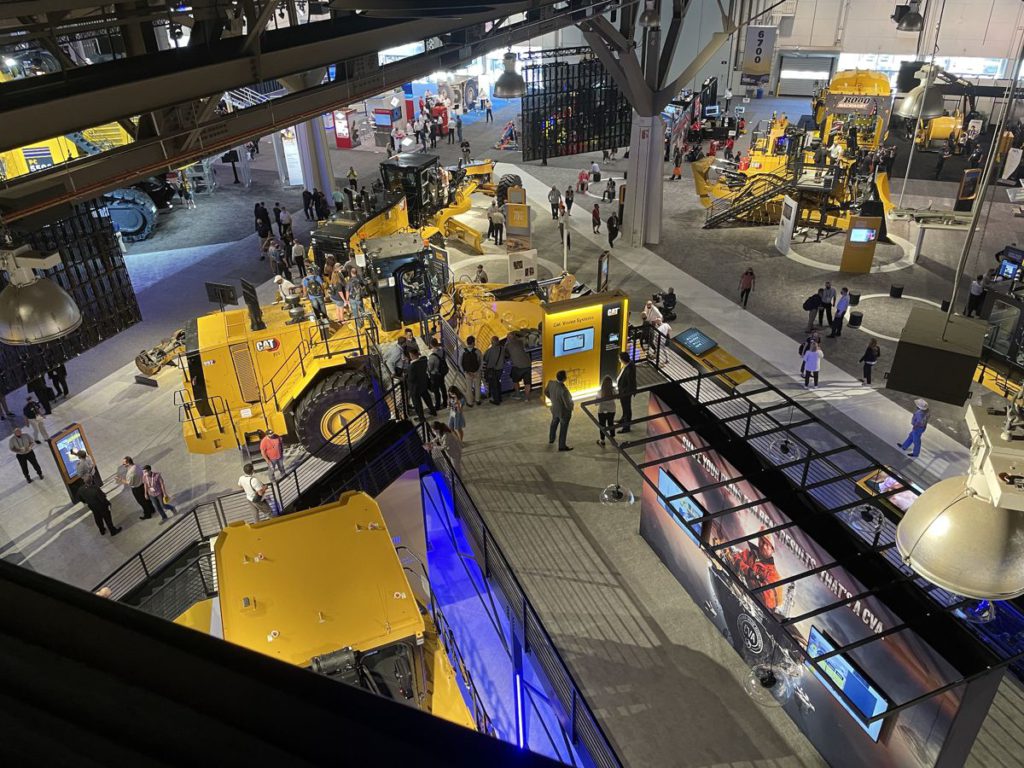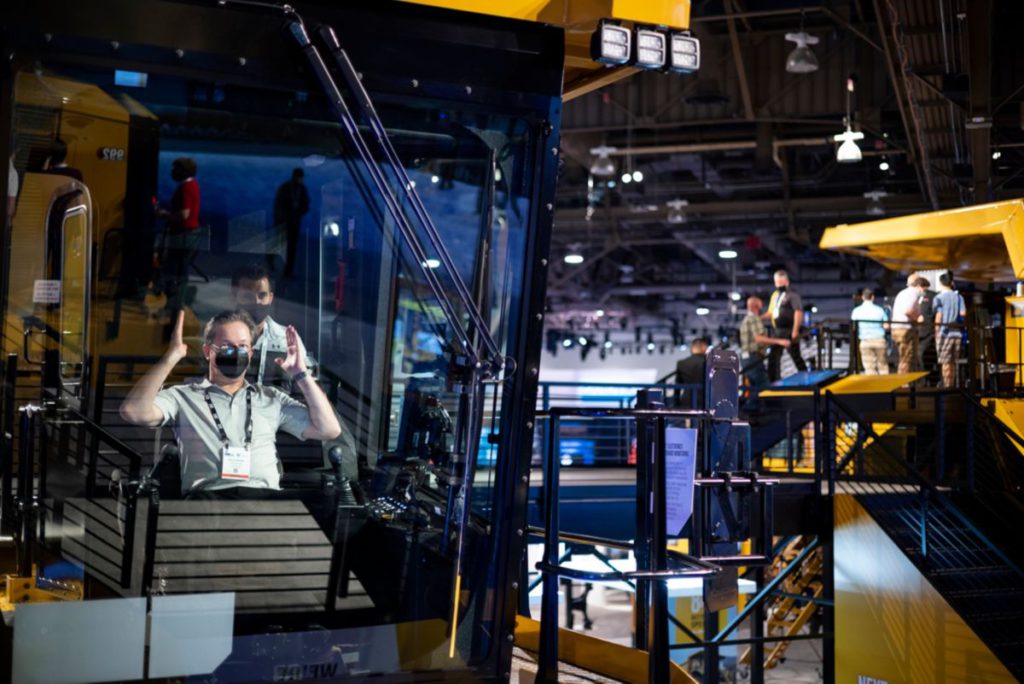Caterpillar gears up for green energy transition, automation age
No gathering of this size is complete without buzzwords, and anyone playing a drinking game where players had to take a shot anytime the word “sustainability” was uttered in the exhibition halls and meeting rooms, would have left Minexpo with a massive hangover, even by Las Vegas standards.
Investor pressure
At Minexpo 2021, MINING.COM sat down with Denise Johnson, Group President for Resource Industries at Caterpillar, the world’s number one manufacturer of construction and mining equipment, to talk about future trends shaping the mining industry.
Caterpillar’s reach is as broad as global mining and apart from 100,000 employees, the Deerfield Illinois-based company’s vast dealership network has another 160,000 workers.
The last time Minexpo took over the Las Vegas Convention Centre was in 2016, when the industry was amidst a brutal downturn. How brutal? Copper bottomed below $2 in January and iron ore at $37 the month before.
The first question to Johnson was an open one, but with a caveat: without mentioning the word sustainability, what is the number one thing keeping Caterpillar’s customers awake at night?
The answer was surprising given how far the industry has come since 2016. The number one issue keeping mining companies awake, according to Johnson is investor pressure. And that investor pressure has only increased over the last year:
“If you talked to mining companies even 12-18 months ago, there wasn’t really as much investor pressure as what you are seeing now.”
“On top of that, whether you’re a small contract miner or a big player, there’s a definite feeling that growth is underway and they want to be very mindful of how they do it this time.”
“You had during the last supercycle a lot of senior mining leaders who lost their jobs because of the decisions that they made. And their approach this time is they are very cautious to make decisions – so there’s more of a pause and reflection.”
Risk on, risk off
But with the green energy transition in full swing, industrial metals near record highs, iron ore a cash cow even at $100 below its peak, and many commentators willing to bandy about the term supercycle, why all this caution?
Yes, there’s optimism, says Johnson, but despite the bullish sentiment on markets, companies are mindful of missteps in investments, how project timelines can be derailed and the need for study instead of moving too fast:
“That’s slowing, in some ways, some of the momentum that could have been building right now.”
“I would say there’s definitely growth, but it’s more controlled growth…which I think will result in longer potential upside as well because it will be drawn out over time.”
In the aftermath of the previous supercycle, MINING.COM was reporting with boring regularity on multi-billion dollar asset writedowns, boardroom purges, and companies suffocating under piles of debt. That period was followed by solemn promises of capital allocation discipline, declaration of the paramountcy of shareholder returns and the death knell for the mega-project.

What emerged from that period is a chastened industry, but with forecasts of near universal above trend growth for industrial metals, requirements for streams of gold and even the perennial laggard – uranium – back in demand, how much longer can the focus be on dividends instead of drills and dozers?
“I think it definitely depends on the company – I come across mining companies that are investing copper and gold that are willing to invest in some of those riskier assets. You always have a few out on the forefront.”
Johnson says with so much variation in outcomes given factors such as government regulations or infrastructure costs or the social licence to operate companies are making sure to take calculated risks.
Market turmoil
Johnson was saying this a couple of weeks before the world’s largest miner – not known for being particularly adventurous – was reported to be looking at the ultimate mining frontier, the Congo.
Johnson also cited Africa as an area of growth for the equipment manufacturer and that includes doing business with many Chinese mining companies in the region.
When asked about rising geopolitical tensions like the trade spat between China and Australia and its impact on mining markets and particularly on Caterpillar’s ability to do business, Johnson was sanguine:
“Do these events [like the upheavals in the Asian thermal coal trade] and shifts in the market impact us? Absolutely. When demand is being pushed into a more cost-competitive region it can definitely make a difference – we’ve seen that flow. But what is interesting, after a few years it can reverse – quickly.
“You have to be able to be flexible in the environment, and I would say from an overall market perspective, we don’t see it shrinking, we see the opportunity to actually be growing, especially as you’re moving into markets that traditionally haven’t had a lot of growth.”
And just how rapidly can markets change? Australian export thermal coal was trading at $50 a tonne a year ago, today it’s setting all-time highs above $200 a tonne while in China shortages have forced domestic prices as high as $300 a tonne.
Green energy transition
The energy transition is forcing mining into the limelight like never before.
Oil and gas never really won the PR battle with the public when it comes to extractive industries. Is the mining industry – particularly hard rock mining – ready for the public scrutiny that is going to come with greater awareness of the metals in electric cars, windmills, solar panels? Are we getting the message out?
“Unfortunately the message is not permeating as it should. A big part of should be broader education of the public, who do not understand what it is that mining companies do.”
“ESG [environment, safety and governance] is top of mind but it’s often not the positive messages that are getting out. There is a lack of awareness of the impact of miners – take Freeport in Indonesia as an example – which are involved with communities for many decades and build schools, hospitals, banks, job programs et cetera.”
Skilled labour shortage
If sustainability was the buzzword of Minexpo, automation came a close second, but automation is probably a stand-in for an underlying problem – a severe and growing labour and skills shortage in the mining industry.
Johnson says the skilled labour shortage extends beyond mining:
“The supply base is feeling it – we’re seeing it everywhere. It’s broad and it’s global. I don’t know how long that will last, and that’s the real key – at what point with everything bouncing around, does that settle out? I think everyone‘s hoping that in the next year we’ll see some improvement.“
Issues of skills and labour are responsible for a “continuing pull on new technology as mining companies try to stabilize their inputs and enhance productivity.”
“For every mining company – every conversation is around automation. I don’t think there’s one conversation we’ve had in the last 12 months, where they haven’t asked about it.
“And it doesn’t have to be full automation – it could be pieces of the business. Some companies aren’t ready to move to automation, but they want some elements on site.” Johnson warns that investing in automation for purposes of labour cost arbitrage is not the right approach. Neither is automation for its own sake:
Automation not for its own sake
“The payoff is in safety, it’s in productivity. But if you don’t change the process, you’re not going to get the result. If you have a bad process and you try to automate it, you’re still going to get a bad result.“
Caterpillar’s mining division has a fast-growing services and solutions business and Johnson says automation goes far beyond equipment:
“So part of what we do when we go in to automate a mine or a system or subset, is looking to take the waste out first, and then automate that process first.
“We have engineers that are sitting with the customer 24/7 and looking at those cycle time improvements that can be made on every loop. We program that in and that becomes your new baseline, so you’re continually improving productivity.
“People, process and continuous improvement drives that, then you’re getting consistency, and then you start a new base, and then you keep going. But it does take time, you don’t get it overnight.”
New bar at Jimblebar
From an operations perspective – particularly so at fly-in fly out sites – having consistent results means meaningful payback for an investment in automation, says Johnson.
Caterpillar points out that its autonomous fleet at Jimblebar, BHP’s Pilbara iron ore mine, has resulted in a 20% improvement in productivity at the mine and a 50% reduction in safety incidents. Last year Jimblebar pulled off a rare feat – exceeding its nameplate capacity of 65 million tonnes per annum, with output of 67.3 million tonnes for 2020.
Overall Caterpillar’s global autonomous truck fleet has racked up more than 3.5 billion hours of operation, each averaging 7,000 hours per year (total number of hours in a year is 8,760) and has not been associated with any workplace injuries.
Attracting tech talent
Minexpo was the second time in 2021 that Caterpillar was showcasing their wares in Las Vegas – the company had a big presence at CES, the consumer electronics show more associated with Nintendo and Playstation than dump-trucks and dozers.

It’s an indication of the fast pace of new technology development and deployment in mining, and with it the nature of Caterpillar’s business including Minestar, its software, data management, monitoring and automation solutions.
“Absolutely we are competing with tech companies, but we’ve learnt through our own experiments, working with partners and other software companies, that if you bring in someone really smart with expertise in a single area like writing software to fix your issue it doesn’t work very well.”
Johnson says one way Caterpillar is able to attract tech talent – which otherwise may have ended up at startups or the big names of Silicon Vallley – is because the company does not just offer a single position:
“We have the opportunity to have a career in a lot of disciplines…and to move within the company and have multiple careers. It’s a global business, our engineers get international assignments and move around.
“If you’re looking for a career with variation, that’s where I feel we have an advantage… You can start out writing software for automation and move onto designing the next iteration of an emissions-free truck.”
“We have all of these ecosystems.”
Those ecosystems are the dozens of partnerships and joint ventures Caterpillar has, with among others DARPA, NASA, Carnegie Mellon.
And working with these giant machines must have its own charms?
“Exactly.”




